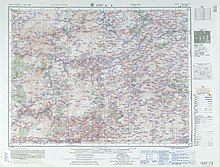I-pin
Appearance
See also: ipin
English
[edit]
Etymology
[edit]From Mandarin 宜賓 / 宜宾 (Yíbīn) Wade–Giles romanization: I²-pin¹.[1]
Proper noun
[edit]I-pin
- Alternative form of Yibin
- 1960 September 23, A Report on Aid to Agricultural Technical Progress Afforded by the Szechwan Chemical Industry[1], United States Joint Publications Research Service, →OCLC, page 4:
- A plant being built in I-pin will produce 6,000 tons of 666 powder annually.
- 1971, Thomas Jay Matthews, “The Cultural Revolution in Szechwan”, in The Cultural Revolution in the Provinces[2], Harvard University Press, →ISBN, →LCCN, →OCLC, →OL, page 96:
- In the early 1960s, following the collapse of Mao's Great Leap Forward, Liu and Chang, as party officials in the city of I-pin (120 miles south of Szechwan's capital, Chengtu), vigorously prosecuted those cadres under their jurisdiction who had shown less than wholehearted devotion to that campaign.
- 1988, Lyman P. Van Slyke, Yangtze: Nature History and the River[3], Addison-Wesley Publishing Company, →ISBN, →LCCN, →OCLC, page 18:
- After crossing Yunnan province, the Long River reaches the sizeable city of I-pin, in southwest Szechwan province. Just above I-pin is the true head of navigation, beyond which no commercial craft can make their way.
Translations
[edit]Yibin — see Yibin
References
[edit]- ^ Yibin, Wade-Giles romanization I-pin, in Encyclopædia Britannica
Further reading
[edit]- “I-pin”, in Merriam-Webster Online Dictionary, Springfield, Mass.: Merriam-Webster, 1996–present.
